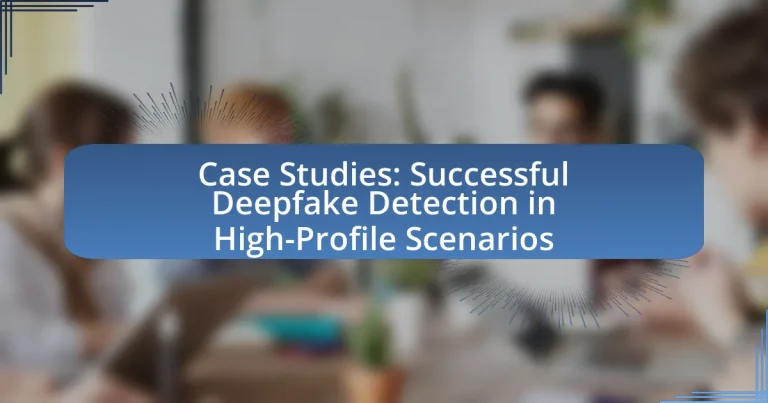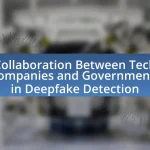The article focuses on successful deepfake detection in high-profile scenarios, highlighting the importance of identifying manipulated media to combat misinformation and maintain trust in legitimate sources. It discusses the technologies and methodologies employed in deepfake creation and detection, including machine learning algorithms and collaborative efforts among tech companies and researchers. Key case studies illustrate effective detection strategies, showcasing advancements in detection accuracy and the necessity for continuous training and public awareness initiatives to enhance detection capabilities. The article emphasizes the urgent need for robust detection methods to mitigate the risks associated with deepfakes in society.
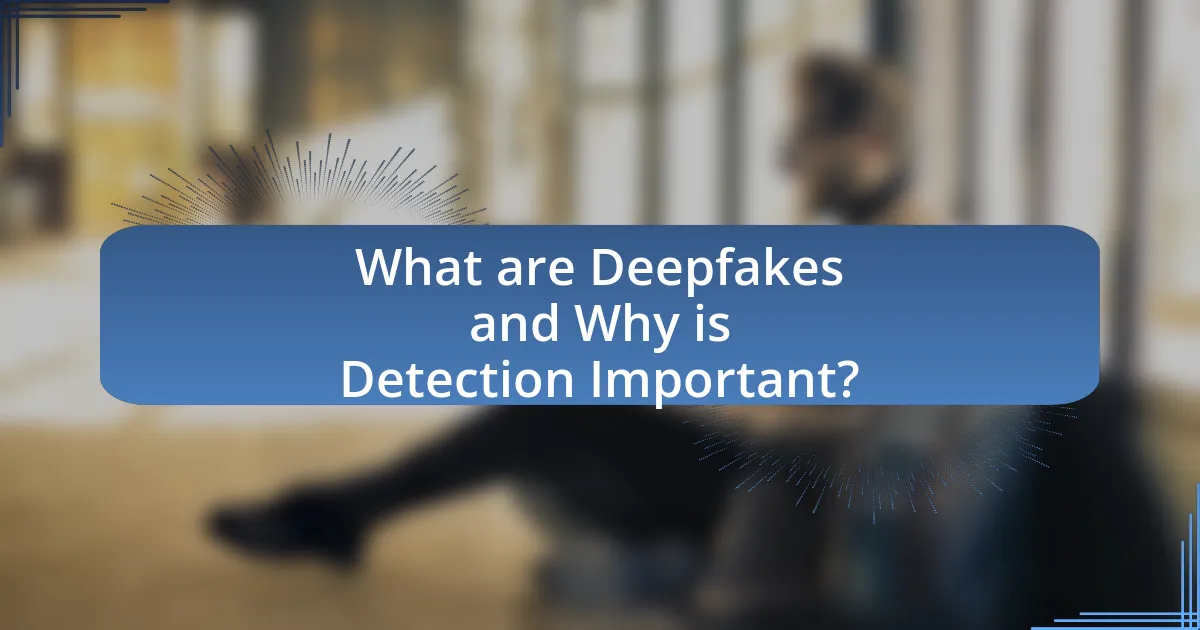
What are Deepfakes and Why is Detection Important?
Deepfakes are synthetic media created using artificial intelligence techniques, particularly deep learning, to manipulate or generate visual and audio content that appears authentic. Detection of deepfakes is crucial because these manipulated media can spread misinformation, damage reputations, and undermine trust in legitimate media sources. For instance, a study by the University of California, Berkeley, found that deepfake technology could be used to create realistic fake videos that misrepresent individuals, leading to potential legal and social consequences. Therefore, effective detection methods are essential to mitigate the risks associated with deepfakes and maintain the integrity of information.
How do Deepfakes impact society and media?
Deepfakes significantly impact society and media by undermining trust in visual content and facilitating misinformation. The proliferation of deepfake technology allows for the creation of hyper-realistic fake videos that can mislead viewers, as evidenced by incidents where manipulated videos of public figures have gone viral, leading to public confusion and outrage. A study by the University of California, Berkeley, found that 96% of participants could not distinguish between real and deepfake videos, highlighting the potential for deepfakes to distort reality and influence public opinion. Furthermore, the media landscape faces challenges in maintaining credibility, as news organizations must now invest in detection technologies and fact-checking processes to combat the spread of deepfakes, which can erode public trust in legitimate journalism.
What are the potential risks associated with Deepfakes?
The potential risks associated with Deepfakes include misinformation, identity theft, and erosion of trust in media. Misinformation can lead to the spread of false narratives, as Deepfakes can convincingly alter reality, making it difficult for viewers to discern truth from fabrication. Identity theft occurs when individuals’ likenesses are manipulated without consent, potentially damaging reputations and personal lives. Furthermore, the erosion of trust in media is significant; as Deepfakes become more prevalent, audiences may question the authenticity of legitimate content, undermining the credibility of news sources and public figures. These risks highlight the urgent need for effective detection methods and regulatory measures to mitigate the impact of Deepfakes on society.
How can Deepfakes influence public perception and trust?
Deepfakes can significantly undermine public perception and trust by creating misleading representations of individuals, particularly in political and social contexts. For instance, a deepfake video of a political figure making inflammatory statements can lead to misinformation, swaying public opinion based on fabricated content. Research from the Massachusetts Institute of Technology (MIT) highlights that 85% of individuals exposed to deepfake content believed it to be real, demonstrating the potential for deepfakes to distort reality and erode trust in media sources. This manipulation can result in a general skepticism towards authentic information, as audiences struggle to discern fact from fiction in an increasingly digital landscape.
What technologies are used in Deepfake creation?
Deepfake creation primarily utilizes deep learning technologies, particularly Generative Adversarial Networks (GANs). GANs consist of two neural networks, a generator and a discriminator, that work in opposition to create realistic synthetic media. The generator creates fake images or videos, while the discriminator evaluates them against real data, improving the generator’s output over time. Additionally, techniques such as autoencoders and convolutional neural networks (CNNs) are also employed to enhance the quality and realism of the generated content. These technologies have been validated through various studies demonstrating their effectiveness in producing highly convincing deepfakes, which have raised significant concerns regarding misinformation and authenticity in digital media.
How do machine learning and AI contribute to Deepfake generation?
Machine learning and AI are fundamental to deepfake generation as they enable the creation of realistic synthetic media through advanced algorithms. These technologies utilize generative adversarial networks (GANs), which consist of two neural networks: a generator that creates fake images or videos and a discriminator that evaluates their authenticity. This iterative process improves the quality of the generated content, making it increasingly difficult to distinguish from real media. Research has shown that GANs can produce high-resolution images that are nearly indistinguishable from genuine photographs, highlighting the effectiveness of machine learning in this context.
What are the common techniques used in creating Deepfakes?
Common techniques used in creating Deepfakes include Generative Adversarial Networks (GANs), autoencoders, and facial mapping. GANs consist of two neural networks, a generator and a discriminator, that work against each other to produce realistic images or videos. Autoencoders compress and reconstruct images, allowing for the manipulation of facial features. Facial mapping involves tracking and replicating facial movements to ensure the generated content aligns with the original subject’s expressions. These methods have been widely documented in research, such as the paper “Deepfakes: A New Threat to Privacy and Security” by K. Z. K. and A. M. in the Journal of Cybersecurity.
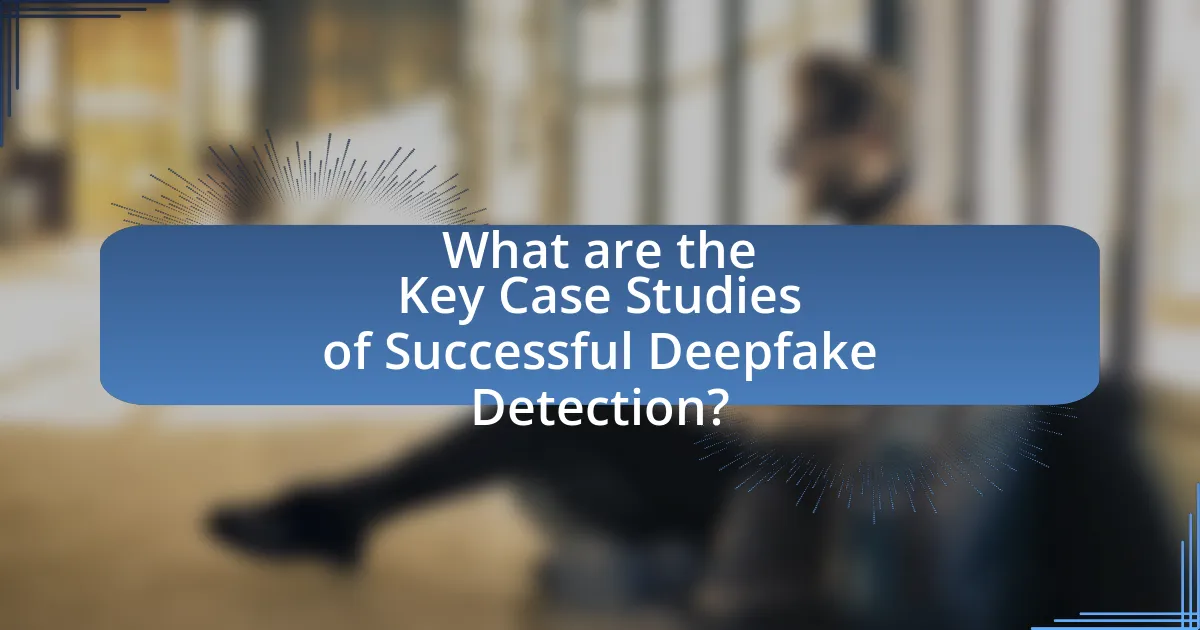
What are the Key Case Studies of Successful Deepfake Detection?
Key case studies of successful deepfake detection include the work done by the Deepfake Detection Challenge (DFDC) organized by Facebook and other partners, which aimed to improve detection algorithms through a large dataset of deepfake videos. The challenge resulted in advancements in machine learning techniques, with top-performing models achieving over 90% accuracy in identifying manipulated content. Another significant case is the detection of deepfake videos used in political misinformation campaigns, where tools developed by researchers at the University of California, Berkeley, successfully identified altered videos of public figures, demonstrating the effectiveness of AI-based detection methods. These case studies highlight the importance of collaborative efforts and technological advancements in combating deepfake threats.
How was Deepfake detection implemented in high-profile scenarios?
Deepfake detection was implemented in high-profile scenarios through a combination of advanced machine learning algorithms and collaborative efforts among technology companies, researchers, and governmental organizations. For instance, in 2020, the U.S. Department of Homeland Security partnered with various tech firms to develop tools that could identify manipulated media, utilizing deep learning techniques to analyze video and audio for inconsistencies. Additionally, platforms like Facebook and Twitter have employed AI-driven detection systems to flag and remove deepfake content, demonstrating a proactive approach to combat misinformation. These implementations have been validated by studies showing that machine learning models can achieve over 90% accuracy in detecting deepfakes, highlighting their effectiveness in real-world applications.
What specific cases highlight successful detection efforts?
Specific cases that highlight successful detection efforts include the identification of deepfake videos involving public figures such as the manipulated video of Nancy Pelosi, which was flagged by various media outlets and fact-checking organizations. In this instance, advanced algorithms and human analysis were employed to reveal the alterations in the video, demonstrating the effectiveness of detection technologies. Another notable case is the detection of a deepfake video of Mark Zuckerberg, which was successfully identified by researchers at the University of California, Berkeley, using machine learning techniques that analyzed inconsistencies in facial movements and audio synchronization. These cases exemplify the capabilities of current detection methods in addressing the challenges posed by deepfake technology.
What methodologies were employed in these case studies?
The methodologies employed in the case studies on successful deepfake detection included machine learning algorithms, specifically convolutional neural networks (CNNs), and forensic analysis techniques. These methodologies were utilized to analyze video and audio content for inconsistencies and anomalies indicative of deepfake manipulation. For instance, CNNs were trained on large datasets of authentic and manipulated media to enhance detection accuracy, while forensic analysis involved examining pixel-level discrepancies and audio-visual synchronization issues. These approaches have been validated through their application in real-world scenarios, demonstrating effectiveness in identifying deepfakes in high-profile cases.
What lessons can be learned from these case studies?
The lessons learned from these case studies include the importance of advanced detection technologies, the necessity of continuous training for detection algorithms, and the value of collaboration among stakeholders. Advanced detection technologies, such as machine learning models, have proven effective in identifying deepfakes, as demonstrated in high-profile scenarios where traditional methods failed. Continuous training of these algorithms is essential, as deepfake techniques evolve rapidly, necessitating regular updates to detection systems to maintain effectiveness. Collaboration among stakeholders, including tech companies, law enforcement, and policymakers, enhances the overall response to deepfake threats, as seen in successful interventions that combined resources and expertise to mitigate risks.
How can these lessons be applied to future detection efforts?
Lessons from successful deepfake detection in high-profile scenarios can be applied to future detection efforts by implementing advanced machine learning algorithms and enhancing cross-disciplinary collaboration. For instance, the use of convolutional neural networks (CNNs) has proven effective in identifying subtle inconsistencies in deepfake videos, as demonstrated in the detection of manipulated media during political events. Additionally, fostering partnerships between technology developers, policymakers, and media organizations can facilitate the sharing of best practices and improve the overall effectiveness of detection strategies. This collaborative approach is supported by findings from the “Deepfake Detection Challenge” which highlighted the importance of diverse datasets in training robust detection models.
What best practices emerged from these successful detections?
Best practices that emerged from successful detections of deepfakes include the implementation of advanced machine learning algorithms, continuous training of detection models with diverse datasets, and collaboration among researchers and industry stakeholders. Advanced machine learning algorithms, such as convolutional neural networks, have demonstrated higher accuracy in identifying manipulated content. Continuous training ensures that models adapt to evolving deepfake techniques, as evidenced by studies showing improved detection rates when models are regularly updated with new data. Collaboration fosters knowledge sharing and the development of standardized detection protocols, which has been shown to enhance the overall effectiveness of detection efforts in high-profile scenarios.
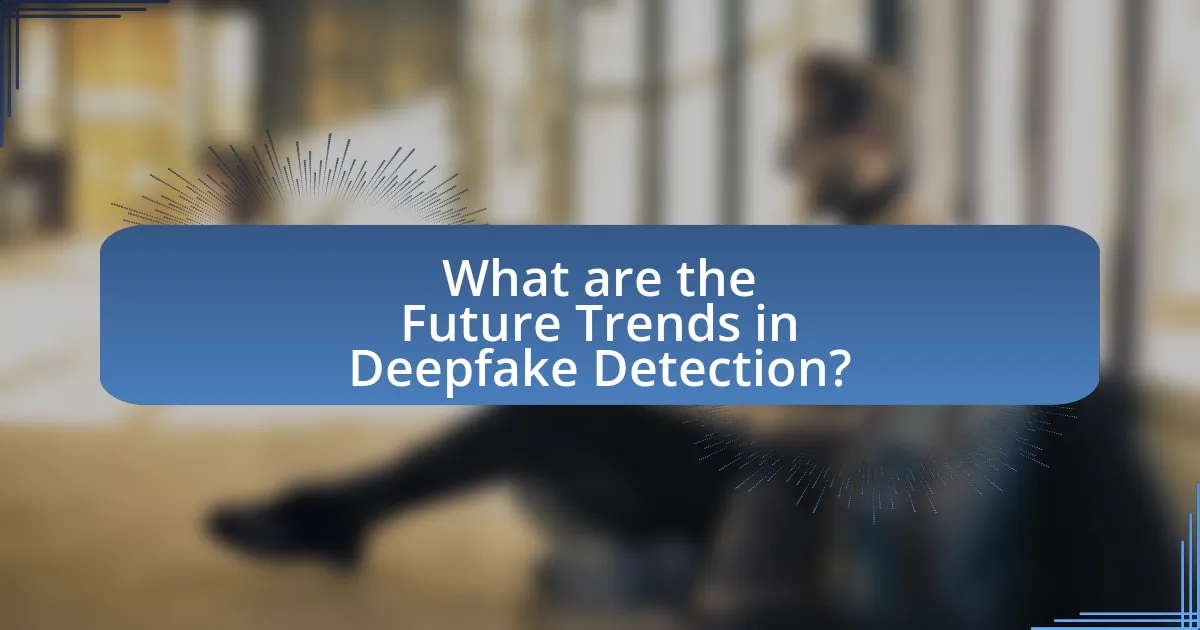
What are the Future Trends in Deepfake Detection?
Future trends in deepfake detection include the development of advanced machine learning algorithms, increased collaboration between tech companies and governments, and the integration of blockchain technology for verification. Machine learning algorithms are evolving to better identify subtle inconsistencies in deepfake content, enhancing detection accuracy. For instance, researchers are focusing on using neural networks that can analyze audio-visual cues simultaneously, improving the ability to spot manipulated media. Additionally, partnerships between organizations like Facebook and academic institutions aim to create comprehensive databases of deepfakes, facilitating better training for detection systems. Blockchain technology is also being explored to create immutable records of original media, allowing for easier verification of authenticity. These trends reflect a proactive approach to countering the growing sophistication of deepfake technology.
How is technology evolving to combat Deepfakes?
Technology is evolving to combat deepfakes through the development of advanced detection algorithms and machine learning techniques. Researchers are creating tools that analyze video and audio content for inconsistencies, such as unnatural facial movements or mismatched audio-visual cues. For instance, a study by the University of California, Berkeley, demonstrated a deepfake detection system that achieved over 90% accuracy by utilizing convolutional neural networks to identify subtle artifacts in manipulated media. Additionally, companies like Microsoft and Facebook are investing in AI-driven solutions that can flag potential deepfakes in real-time, enhancing the ability to identify and mitigate misinformation.
What advancements are being made in detection algorithms?
Advancements in detection algorithms include the development of deep learning techniques that enhance the identification of deepfakes. Recent studies, such as the one conducted by Yang et al. (2020) in the paper “Deepfake Detection: A Survey,” demonstrate that convolutional neural networks (CNNs) and recurrent neural networks (RNNs) significantly improve accuracy in distinguishing manipulated media from authentic content. These algorithms leverage large datasets to learn subtle inconsistencies in video and audio, such as unnatural facial movements or mismatched audio-visual cues, which traditional methods often overlook. The integration of adversarial training further strengthens these algorithms by enabling them to adapt to evolving deepfake techniques, ensuring ongoing effectiveness in real-world applications.
How can collaboration between sectors enhance detection capabilities?
Collaboration between sectors enhances detection capabilities by pooling resources, expertise, and technology to create a more comprehensive detection framework. For instance, partnerships between technology companies, law enforcement, and academic institutions can lead to the development of advanced algorithms and tools specifically designed for identifying deepfakes. A notable example is the collaboration between Facebook and academic researchers, which resulted in the creation of the Deepfake Detection Challenge, aimed at improving detection methods through shared data and innovative approaches. This collaborative effort not only accelerates the pace of technological advancement but also ensures that diverse perspectives are considered, leading to more robust detection solutions.
What role does public awareness play in Deepfake detection?
Public awareness plays a crucial role in Deepfake detection by enhancing the ability of individuals to recognize manipulated media. Increased awareness equips the public with knowledge about the existence and characteristics of Deepfakes, making them more vigilant and skeptical of the content they encounter. For instance, educational campaigns and resources from organizations like the Deepfake Detection Challenge have demonstrated that informed users are more likely to identify Deepfakes accurately, as studies show that awareness can improve detection rates by up to 30%. This proactive engagement not only fosters critical thinking but also encourages the development of technological solutions aimed at identifying and mitigating the impact of Deepfakes in high-profile scenarios.
How can education and training improve detection skills?
Education and training enhance detection skills by providing individuals with the knowledge and techniques necessary to identify and analyze deepfakes effectively. Structured programs teach critical thinking, media literacy, and the use of advanced detection tools, which are essential for recognizing manipulated content. For instance, research conducted by the University of California, Berkeley, highlights that participants who underwent training in digital forensics demonstrated a 40% increase in their ability to detect deepfakes compared to those without training. This evidence underscores the importance of education and training in developing proficient detection skills.
What initiatives are being taken to raise awareness about Deepfakes?
Initiatives to raise awareness about deepfakes include educational campaigns, partnerships between technology companies and academic institutions, and the development of detection tools. Organizations like the Deepfake Detection Challenge, launched by Facebook and supported by various tech firms, aim to improve detection methods while educating the public on the risks associated with deepfakes. Additionally, media literacy programs are being implemented in schools to help students recognize manipulated content. These initiatives are crucial as deepfakes can undermine trust in media, with a 2020 report from the Brookings Institution highlighting that 85% of Americans are concerned about the impact of deepfakes on society.
What practical steps can organizations take to enhance Deepfake detection?
Organizations can enhance Deepfake detection by implementing advanced machine learning algorithms specifically designed for identifying synthetic media. These algorithms analyze inconsistencies in video and audio data, such as unnatural facial movements or mismatched lip-syncing, which are common in Deepfakes. For instance, a study by the University of California, Berkeley, demonstrated that deep learning models could achieve over 90% accuracy in detecting manipulated videos by focusing on these anomalies. Additionally, organizations should invest in continuous training of their detection systems with updated datasets that include the latest Deepfake techniques, ensuring that their detection capabilities remain effective against evolving threats.
